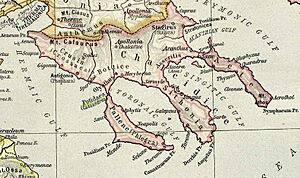Battle of Potidaea facts for kids
Quick facts for kids Battle of Potidaea |
|||||||
|---|---|---|---|---|---|---|---|
 Map of Chalcidice. Ancient Stagira is located on the coast north of that at the position labeled "Caprus", the name of the island off the coast of Stagira. |
|||||||
|
|||||||
| Belligerents | |||||||
| Athens | Corinth Potidaea |
||||||
| Commanders and leaders | |||||||
| Archestratus Callias † |
Aristeus | ||||||
| Strength | |||||||
| 70 ships, 3,000 hoplites, 400 cavalry |
1,600 hoplites, 400 light troops, 200 cavalry |
||||||
| Casualties and losses | |||||||
| 150 men | 300 men | ||||||
The Battle of Potidaea was an important fight in 432 BC. It happened between the powerful city of Athens and a combined army from Corinth and Potidaea, along with their friends. This battle, along with another one called the Battle of Sybota, helped start the big Peloponnesian War. This war was a huge conflict between Athens and Sparta, lasting for many years.
Contents
Why the Battle Started
Potidaea was a city that was originally founded by people from Corinth. It was located on the Chalcidice peninsula. Even though it was a Corinthian colony, Potidaea was also part of the Delian League, which was led by Athens. This meant Potidaea had to pay money (tribute) to Athens every year. Corinth still sent its own officials to Potidaea each year.
Athens Gets Worried
After a defeat for Athens at Sybota, Athens became worried about Potidaea. They feared Potidaea might rebel. This was because of influence from Corinth and Macedon, led by King Perdiccas II of Macedon. Perdiccas was encouraging other cities allied with Athens to revolt.
Athens then made some tough demands on Potidaea. They told Potidaea to tear down part of its city walls. They also demanded that Potidaea stop letting Corinthian officials into their city. Finally, Athens asked Potidaea to send important people (hostages) to Athens. This was to show they would obey.
Potidaea Rebels
Athens was worried that Potidaea would revolt. Their demands actually caused the revolt to happen. To make sure their demands were followed, Athens sent an army. This army was led by a general named Archestratus. They were sent because of the growing tension with Corinth and Macedon.
The Battle Begins
Athens first gathered a fleet of 30 ships and 1,000 hoplites. Hoplites were heavily armed foot soldiers. This force was originally meant to fight King Perdiccas in Macedon. But it was sent to Potidaea instead. This happened because the people of Potidaea had already revolted. They had also become allies with Perdiccas.
Corinth Sends Help
The people of Potidaea sent messages to Athens and Sparta. When talks with Athens failed, Sparta promised to help Potidaea. Sparta said they would invade Attica, the region around Athens.
Corinth sent 1,600 hoplites and 400 light troops to Potidaea. These soldiers were led by a commander named Aristeus. Corinth called these soldiers "volunteers." They hoped this would prevent a bigger war from starting.
Athenian Reinforcements
In response, Athens sent more troops. They sent another 2,000 hoplites and 40 more ships. These new forces were commanded by Callias. The combined Athenian forces first fought against Perdiccas. Then, they sailed to Potidaea and landed there. Perdiccas and 200 of his cavalry (soldiers on horseback) joined Aristeus. Their combined army marched towards Potidaea.
Fighting on the Battlefield
In the battle that followed, Aristeus's group of Corinthian soldiers managed to defeat a part of the Athenian line. But in other areas, the Athenians were winning. Aristeus tried to get back to Potidaea along the coast. He wanted to avoid the main Athenian army.
A group of Potidaean soldiers from a nearby city called Olynthus tried to help Aristeus. But they were also defeated. The Corinthians and Potidaeans lost about 300 men in total. The Athenians lost about 150 men, including their commander Callias. The Macedonian cavalry did not join the main fighting.
The Long Siege
The Athenians stayed outside Potidaea for a long time. They were joined by another 1,600 hoplites. These new soldiers were led by a general named Phormio. Both sides built walls. The Athenians built walls around Potidaea to trap the city. They also blocked Potidaea from the sea with their ships. This was called a naval blockade.
War is Declared
While the siege was happening, representatives from Corinth, Athens, and Sparta met in Sparta. These meetings led to a formal declaration of war. This was the start of the big Peloponnesian War.
The siege of Potidaea lasted for a very long time, until 430 or 429 BC. It cost Athens a lot of money. They spent as much as 420 talents each year on the military effort. This was a huge amount of money.
Impact on Athens
Spending so much money was not popular with the people of Athens. Also, a terrible sickness called the plague swept through Athens. These problems made it hard for their leader, Pericles, to keep leading. Pericles had a plan to protect Athens by staying behind their strong Long Walls. He also thought the Peloponnesians would run out of money quickly. But the long siege and the plague made his plan seem less effective to the Athenians.
Socrates in Battle
Interestingly, the famous philosopher Socrates was a soldier in the Battle of Potidaea. This is mentioned in some of Plato's writings. It is even said that Socrates saved the life of another famous Athenian, Alcibiades, during this battle.
See also
 In Spanish: Batalla de Potidea para niños
In Spanish: Batalla de Potidea para niños

